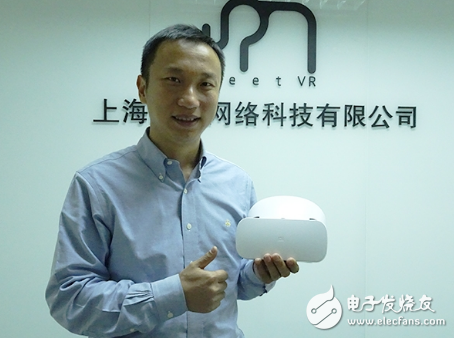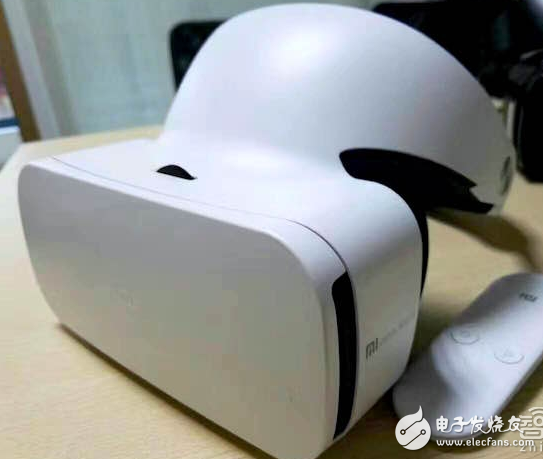Lead: Meet Li Shuxin at the platform of the Tencent VR Developer Salon at the end of last year. After 11 months, I saw him again and was the founder and CEO of Shanghai Moxiang Technology. Mentioning the elephant may be strange. To put it another way, Xiaomi’s newly incorporated VR eco-chain company is also the creator behind the official version of Xiaomi VR glasses.
Last month, Lei Jun held the white version of Xiaomi VR glasses and officially released it. Now it has been sent to developers in succession, and friends can see new photos of receipts from time to time. It is expected that this helmet will be officially sold in early December.
Now, the ecological chain company behind this millet VR glasses has surfaced.

Recently, Zhiwu exclusive interview with Li Shuxin, founder of Moxiang Technology. He told us about the team's product development and entrepreneurial journey in the past six months, and Xiaomi and some cooperation details were revealed. In addition, after the angel round investment of Xiaomi was harvested in April this year, Moxiang Technology won the second round of investment from Jingdong. The cooperation between the two companies at the business level also received the first positive response. The direction of cooperation with Jingdong may become similar to Ali Buy+. VR shopping scene application.
First, Tencent has been rooted in semiconductor for more than ten years.Compared with Li Shuxin, who was seen on the Tencent podium last year, he looks very approachable. High, slow speech, clear conditioning, and the typical entrepreneurs who are passionate and full of blood are obviously two styles.
Although entering middle age, "Mo Xiang" is also the first venture in Li Shuxin's life. Previously, he served as technical director at the Intelligent Equipment Innovation Center in Tencent, Shenzhen, where he was responsible for selecting smart hardware innovation projects with feasibility and application prospects. Going forward, Li Shuxin has worked in many internationally renowned chips and IP companies for more than ten years.
Let us first dial the clock back to the beginning of this century, the Internet has just emerged, and the chip battlefield is dominated. After graduating, Li Shuxin has been at Intel for many years and has participated in the XScale embedded project team. This is a mobile terminal developed by Intel earlier. Unfortunately, the project team was sold to Marvell in 2006, which made Intel miss the huge dividend in the era of smart phones.
Subsequently, Li Shuxin came to MIPS, the world's leading semiconductor design IP company. If the electronic products that Li Shuxin contacted before were mainly 3C, then the experience of MIPS allowed him to participate in and receive more fields, such as NFC chips, wireless routers and high-performance computers. Later, when I entered ARM, Li Shuxin still focused on the work of technical consultants. "This experience has exposed me to many types of hardware projects, covering a wide range of companies, and more importantly, I have heard many successful and failed project experiences." .
In the work experience of several semiconductor giants, Li Shuxin witnessed the important changes in the era of mobile chips. He also accumulated considerable experience in software and hardware development for Li Shuxin, and has a deeper understanding of how to combine the underlying technologies and applications.
Second, from the giant VR department to independent entrepreneurshipIn 2014, Li Shuxin began to formally enter the Internet field. After many communication and exchanges with related personnel of Tencent, Li Shuxin came to Shenzhen Tencent from Shanghai and founded Tencent Intelligent Equipment Innovation Center together with Tian Gang. Li Shuxin is mainly responsible for technology and products.
“This department is mainly to select new hardware innovation projects for Tencent, and then invest in key developments, similar to internal entrepreneurship.†Li Shuxin introduced. He said that he has seen many hardware projects during his two years in service, but he still has a soft spot for VR. "Remember to contact VR for the first time, or use the Cardborad class of products, experienced a 3D game, a horror film at the time." Li Shuxin remembered this. Later, he gradually realized that this kind of product is different. "The kind of experience is that people can't feel through the screen of the mobile phone." Li Shuxin believes that the deeper meaning of VR is to provide more realistic and rich experiences for those whose physical and physical environments are subject to objective restrictions.
At the end of 2015, we saw Tencent's internal attention to VR innovation projects and related voices. So, why did Li Shuxin choose to start an independent venture at this time?
"Initiating in a large company, you only have one investor, your boss, who refuses to pay and resources can only rely on him to make a decision; but the latter is the whole capital and user market, there can be More choices, to a greater extent adhere to their own ideas." In Li Shuxin's view, independence is to adhere to his own philosophy.
According to Li Shuxin, there were several projects promoted within Tencent at the same time, not concentrated on VR single projects. “Limited to research and conceptual stages, no landing on physical productsâ€.
In addition, based on previous experience with chips and projects, Li Shuxin was keenly aware that “the industrial revolution that will be brought about after the rise of VR technology has great potential and is a rare opportunity for entrepreneurship. It is very suitable to enter the market at this time of the year. of".

In April of this year, Li Shuxin officially resigned from Tencent and founded Moxiang Technology. The team is currently about 40 people, located in Shanghai, Beijing and Dongguan. The Shanghai headquarters is mainly responsible for hardware development and design, the Beijing branch is responsible for content development, and the Dongguan department is responsible for production and manufacturing.
He has been working in Tencent Shenzhen before. The reason why he wants to set up his headquarters in Shanghai is that Li Shuxin mainly considers that the hardware underlying and chip company headquarters are located in Shanghai, and he has accumulated a wealth of relevant talents. At the same time, Li Shuxin's accumulated contacts and resources in Shanghai in the early years are also important reasons.
According to Li Shuxin, the Moxiang technology team is characterized by “excellent†and each has its own duties. The border beans of each person’s position are very clear. "There are not many 40 people, but there are more than 20 posts, such as graphics calculations, sensors, structured light, video algorithms, etc." Li Shuxin believes that although the VR helmet is only a single product, it needs to integrate technology and talents from multiple fields.
The team has accumulated a lot of skills in all fields, and it still needs to be comprehensive in the overall grasp and overall planning. Li Shuxin introduced that the two colleagues at Intel had helped a lot. As a partner, Pu Hanlai is a Ph.D. in the semiconductor field, mainly responsible for the control of products; another Gu Qinwei, in addition to the chip industry background, also worked in Internet companies such as Cheetah.
"The team is divided into three places mainly considering the geographical factors." On the other hand, a team that is too dispersed may cause inconvenience in communication and communication. In this regard, Li Shuxin said that in the management of the team, mainly he is running around. The three teams have their own functions, and they usually use instant messaging.
Steel structures can be used in many industries such as foundation reinforce, electric power transmission structures and tubular scaffolding, etc.
A flange can also be a plate or ring to form
a rim at the end of a pipe when fastened to the pipe. A blind flange is a plate
for covering or closing the end of a pipe. A flange joint is a connection of
pipes, where the connecting pieces have flanges by which the parts are bolted
together.
Although the word flange generally refers to
the actual raised rim or lip of a fitting, many flanged plumbing fittings are
themselves known as 'flanges':
There are many
different flange standards to be found worldwide. To allow easy functionality
and interchangeability, these are designed to have standardised dimensions.
Common world standards include ASA/ASME (USA), PN/DIN (European), BS10
(British/Australian), and JIS/KS (Japanese/Korean). In the USA, ANSI stopped
publishing B16.5 in 1996, and the standard is ASME B16.5
Steel Structures,Steel Structure Building,Classic Steel Structure,Light Steel Structures
Yixing Steel Pole International Trading Co., Ltd , https://www.yx-steelpole.com